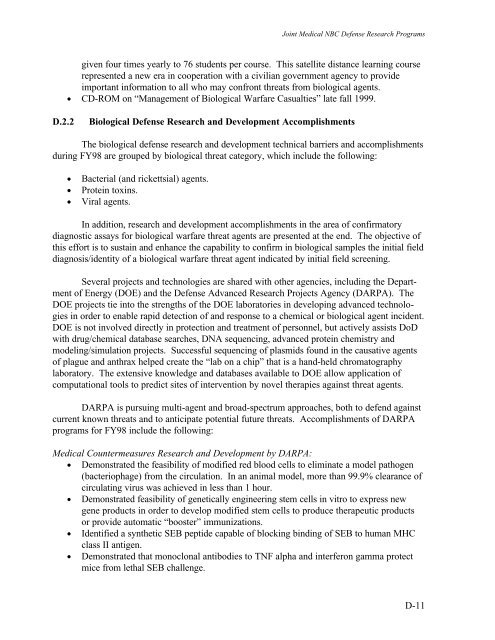Nuclear/Biological/Chemical (NBC) Defense - Federation of ...
Nuclear/Biological/Chemical (NBC) Defense - Federation of ...
Nuclear/Biological/Chemical (NBC) Defense - Federation of ...
Create successful ePaper yourself
Turn your PDF publications into a flip-book with our unique Google optimized e-Paper software.
Joint Medical <strong>NBC</strong> <strong>Defense</strong> Research Programs<br />
given four times yearly to 76 students per course. This satellite distance learning course<br />
represented a new era in cooperation with a civilian government agency to provide<br />
important information to all who may confront threats from biological agents.<br />
• CD-ROM on “Management <strong>of</strong> <strong>Biological</strong> Warfare Casualties” late fall 1999.<br />
D.2.2 <strong>Biological</strong> <strong>Defense</strong> Research and Development Accomplishments<br />
The biological defense research and development technical barriers and accomplishments<br />
during FY98 are grouped by biological threat category, which include the following:<br />
• Bacterial (and rickettsial) agents.<br />
• Protein toxins.<br />
• Viral agents.<br />
In addition, research and development accomplishments in the area <strong>of</strong> confirmatory<br />
diagnostic assays for biological warfare threat agents are presented at the end. The objective <strong>of</strong><br />
this effort is to sustain and enhance the capability to confirm in biological samples the initial field<br />
diagnosis/identity <strong>of</strong> a biological warfare threat agent indicated by initial field screening.<br />
Several projects and technologies are shared with other agencies, including the Department<br />
<strong>of</strong> Energy (DOE) and the <strong>Defense</strong> Advanced Research Projects Agency (DARPA). The<br />
DOE projects tie into the strengths <strong>of</strong> the DOE laboratories in developing advanced technologies<br />
in order to enable rapid detection <strong>of</strong> and response to a chemical or biological agent incident.<br />
DOE is not involved directly in protection and treatment <strong>of</strong> personnel, but actively assists DoD<br />
with drug/chemical database searches, DNA sequencing, advanced protein chemistry and<br />
modeling/simulation projects. Successful sequencing <strong>of</strong> plasmids found in the causative agents<br />
<strong>of</strong> plague and anthrax helped create the “lab on a chip” that is a hand-held chromatography<br />
laboratory. The extensive knowledge and databases available to DOE allow application <strong>of</strong><br />
computational tools to predict sites <strong>of</strong> intervention by novel therapies against threat agents.<br />
DARPA is pursuing multi-agent and broad-spectrum approaches, both to defend against<br />
current known threats and to anticipate potential future threats. Accomplishments <strong>of</strong> DARPA<br />
programs for FY98 include the following:<br />
Medical Countermeasures Research and Development by DARPA:<br />
• Demonstrated the feasibility <strong>of</strong> modified red blood cells to eliminate a model pathogen<br />
(bacteriophage) from the circulation. In an animal model, more than 99.9% clearance <strong>of</strong><br />
circulating virus was achieved in less than 1 hour.<br />
• Demonstrated feasibility <strong>of</strong> genetically engineering stem cells in vitro to express new<br />
gene products in order to develop modified stem cells to produce therapeutic products<br />
or provide automatic “booster” immunizations.<br />
• Identified a synthetic SEB peptide capable <strong>of</strong> blocking binding <strong>of</strong> SEB to human MHC<br />
class II antigen.<br />
• Demonstrated that monoclonal antibodies to TNF alpha and interferon gamma protect<br />
mice from lethal SEB challenge.<br />
D-11
















